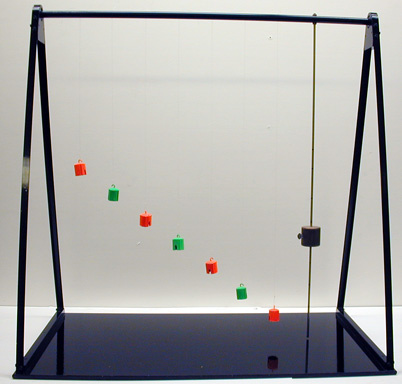Breadcrumb
3A60.30 - Barton's Pendula

Code Number: 3A60.30
Demo Title: Barton's Pendula
Condition: Good
Principle: Simple Harmonic Motion
Area of Study: Oscillations & Acoustics
Equipment:
Barton's Pendula Apparatus.
Procedure:
Adjust the large driving pendula to a desired height and set into motion. After a few oscillations one of the pendula should be oscillating in resonance with the driving pendula, but almost 180 degrees out of phase.
References:
- Yi Jinn Chen, Shuo-Hong Wang, Jiann-Shing Lih, Tzu-Chun Chen, Jeng-Fung Hung, and Jing-Yuan Ko, "A Metronome Drives a Pendulum in Resonace", TPT, Vol. 63, #5, May 2025, p. 330.
- Thomas B. Greenslade Jr., "Sympathetic Resonance: A New Use for an Old Demonstration", TPT, Vol. 50, #6, Sept. 2012, p. 369.
- Timothy J. Moran, Bradford K. Hill, "Apparatus for Teaching Physics - Inexpensive Resonance Analysis", TPT, Vol. 47, # 9, December 2009, p. 599.
- Wojciech Dindorf, "String of Pearls Resonance", TPT, Vol. 39, # 4, Apr. 2001, p. 251.
- Eduardo C. Valadares and Cleber P. A. Anconi, "Dancing to the Music", TPT, Vol. 38, # 7, Oct. 2000, p. 404.
- John D. McGervey, "Hands-On Physics for Less Than a Dollar per Hand", TPT, Vol. 33, # 4, p. 238 - 241, April 1995.
- Terry A. Scott, "Resonance Demonstrator", TPT, Vol. 21, # 6, Sept. 1983, p. 409.
- Shirin Haque-Copilah, "Extremely Simple Demonstration of Forced Oscillation", AJP, Vol. 64, #4, Apr. 1996, p. 507.
- Richard E. Berg, "Pendulum Waves: A Demonstration of Wave Motion Using Pendula", AJP, 59, # 2, Feb. 1991, p. 186.
- Sd-1: Freier and Anderson, A Demonstration Handbook for Physics.
- 13.29: Tik Liem, "How Many Swings Can You Get?", Investigation to Science Inquiry, p. 347.
- Brown, Science for You-112 Illustrated Experiments, p. 95.
- "Coupled Resonant Pendulums", Exploratorium Science Snackbook - Force and Motion, p. 32- 35.
- 3.16: Charles Taylor, The Art and Science of Lecture Demonstration, p. 150-151.
- "Resonator", Science Snackbook, The Exploratorium.
- Ron Hipschman, "Resonant Pendulum", Exploratorium Cookbook II, 85.1 - 85.4